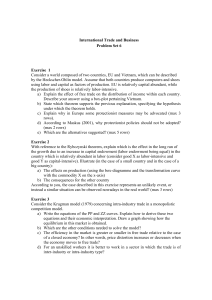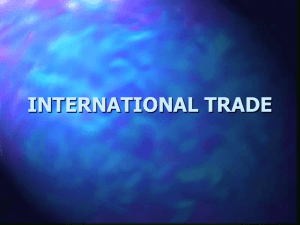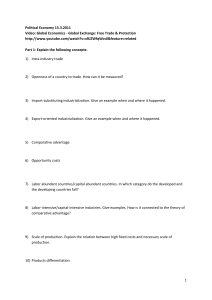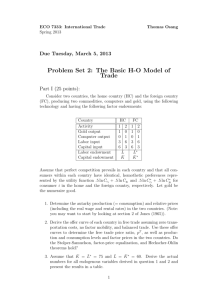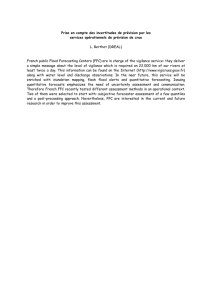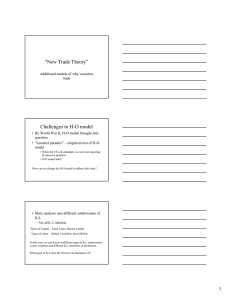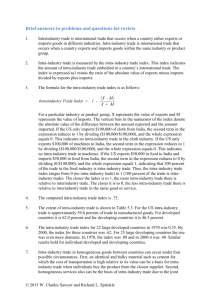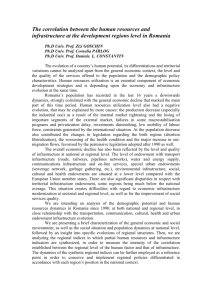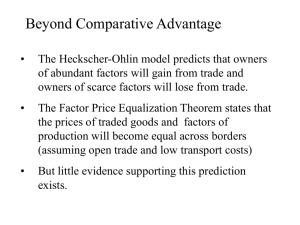Do Factor Endowments Matter for North-North Trade? by Donald R. Davis
advertisement
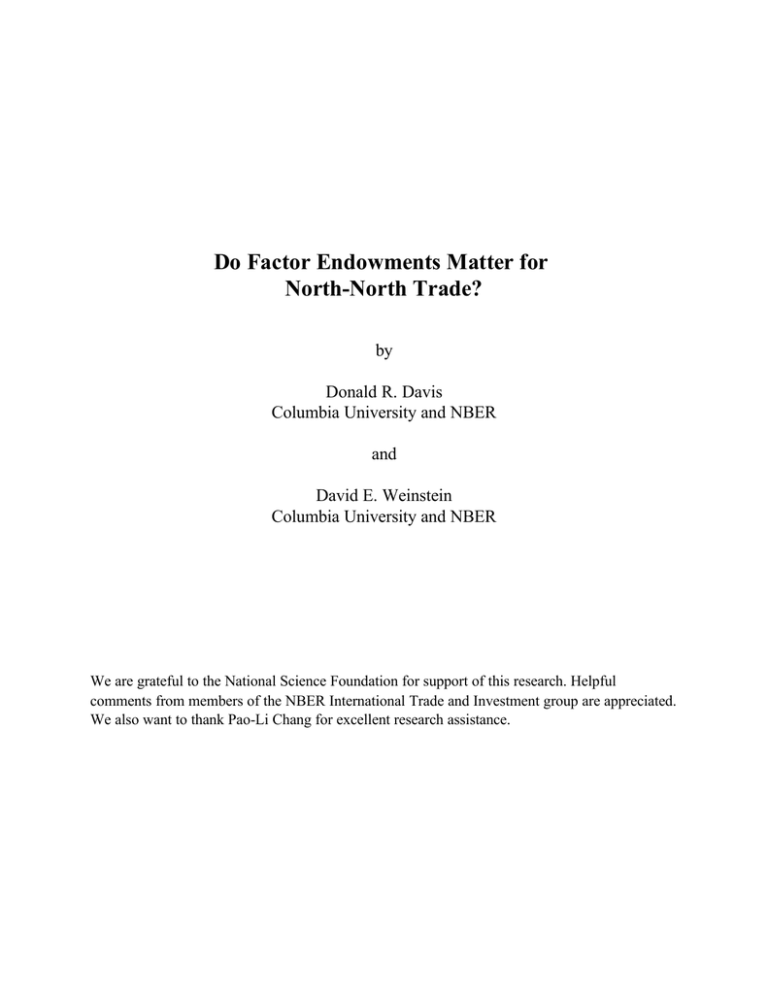
Do Factor Endowments Matter for
North-North Trade?
by
Donald R. Davis
Columbia University and NBER
and
David E. Weinstein
Columbia University and NBER
We are grateful to the National Science Foundation for support of this research. Helpful
comments from members of the NBER International Trade and Investment group are appreciated.
We also want to thank Pao-Li Chang for excellent research assistance.
Do Factor Endowments Matter for
North-North Trade?
Abstract
The dominant paradigm of world trade patterns posits two principal features. Trade between
North and South arises due to traditional comparative advantage, largely determined by
differences in endowment patterns. Trade within the North, much of it intra-industry trade, is
based on economies of scale and product differentiation. The paradigm specifically denies an
important role for endowment differences in determining North-North trade. This paper provides
the first sound empirical examination of this question. We demonstrate that trade in factor
services among countries of the North is systematically related to endowment differences and
large in economic magnitude. Intra-industry trade, rather than being a puzzle for a factor
endowments theory, is instead the conduit for a great deal of this factor service trade.
Do Factor Endowments Matter for North-North Trade?
The new trade theory of the 1980's is primarily recognized for its novel contributions
regarding increasing returns, product differentiation and imperfect competition.1 Yet the influence
of this literature goes beyond simply adding a few new models to the canon. In a pair of influential
papers, Krugman (1981) and Helpman (1981) articulated a vision of world trade patterns that
integrated the new trade theory with the traditional factor endowments theory of HeckscherOhlin. In this formulation, each theory plays a role, but the roles differ. Trade among rich
countries of the North is intra-industry and takes advantage of gains from specialization in a world
of scale economies. Trade between North and South is inter-industry based on differences in
factor endowments. This hybrid paradigm is now the profession’s dominant vision of the
determinants of world trade patterns.
In arguing for the empirical relevance of the scale economies element of this paradigm,
Krugman (1981) cited two seeming-paradoxes in world trade patterns when viewed through a
factor endowments lens: “First, much of world trade is between countries with similar factor
endowments. Second, a large part of trade is intra-industry in character – that is, it consists of
two-way trade in similar products.”2 In effect, this paradigm specifically denied that factor
endowment differences are important for understanding trade among the rich countries of the
North, for which instead it turns to the new trade theory. And the predominance of intra-industry
1
2
See the seminal papers of Krugman (1979) and Lancaster (1980).
These observations about trade patterns were offered specifically to motivate a move to
the new trade theory view which could account for these facts even among countries with
identical endowments. Krugman (1980) also appealed to one element apart from trade patterns:
an apparent absence of substantial distributional impact of trade reform.
trade is also viewed as a puzzle, because this is viewed as trade in goods of similar factor
intensity.3
The present paper provides the first sound empirical scrutiny of the role of factor
endowments in determining North-North trade. It has not been possible to examine this empirical
issue previously because the literature on trade in factor services was dominated by anomalies and
conundrums, such as Trefler’s (1995) “mystery of the missing trade” and Gabaix’s (1997)
“rejection of the Heckscher-Ohlin-Leontief hypothesis,” rather than models that match well with
the data.4 Recently, Davis and Weinstein (2001) have provided a simple theoretical framework
that provides a surprisingly strong match between prediction and data for trade in factor services.
This is the starting point for the present paper.
We will say that endowment differences are important for North-North trade if two
criteria are met: (1) Factor service trade among countries of the North is systematically related to
endowment differences; and (2) The magnitude of factor service trade is economically large. Our
results show that both criteria are met.
This implies that the core vision of the determinants of world trade patterns needs to be
amended, particularly as it pertains to trade among the rich countries of the North. As the current
paradigm suggests, scale economies and product differentiation may well be important for trade
3
Helpman and Krugman (1985, p. 2) discuss the issue of intra-industry trade as follows:
“In particular, countries should export goods whose factor content reflects their underlying
resources. This is in fact by and large true of countries’ net exports. But to casual observation,
and on more careful examination, actual trade patterns seem to include substantial two-way trade
in goods of similar factor intensity. This ‘intraindustry’ trade seems both pointless and hard to
explain from the point of view of a conventional trade analysis.” This perspective is evident as
well in virtually all recent editions of trade textbooks. See also Davis (1997) for a discussion.
4
Cf. Bowen, Leamer, and Sveikauskas (1987), Trefler (1995), and Gabaix (1997).
2
within the North – nothing that we do contests this. What we show is that endowments matter not
only for North-South trade, but for trade within the North as well. Factor service trade for
countries of the North is systematic, economically large, and frequently more intensively directed
toward other countries of the North than toward the South.
Moreover, our work forces a reconsideration of the role of intra-industry trade.
Conventionally its importance for bilateral trade among countries of the North is taken as
evidence that endowments do not matter for this trade. What we show instead is that, when
properly conceived and measured, intra-industry trade is instead one of the principal conduits of
factor service trade for countries of the North. Indeed, recent work by Schott (2000) supports
our interpretation. Schott examines highly disaggregated (10 digit harmonized trade system) US
import data and finds evidence of great variation in unit values, which is consistent with intraindustry exchange being distinct goods with distinct input ratios.
We develop this paper in three additional sections. Section II articulates our basic
theoretical framework, develops some new results regarding factor service trade with well-defined
classes of countries, and provides a theoretical decomposition relating our measures to those
employed in previous empirical work. Section III derives the principal empirical results. Section
IV concludes.
II. Theory
The starting point for an investigation of the role of trade in factor services must be
measurement. The classic framework for measuring trade in factor services is due to Vanek
(1968). Trefler (1993, 1995) amends this in an adjusted factor price equalization framework to
3
allow either for factor-augmenting or for Hicks-neutral technical differences. Deardorff (1982)
and Helpman (1984) develop versions that are highly relevant for our work here, which allow for
differences in relative factor prices across countries that cannot be handled as simple factoraugmenting differences. Davis and Weinstein (2001) develop a variant of the Deardorff-Helpman
model with explicit consideration of the nature of technical differences, as well as the presence of
non-traded goods, and show that such a model has substantial empirical support.
Here our concern is to move beyond a test of the theory to understand some key questions
for which magnitudes matter. Is factor service trade important for countries of the North? If so,
what is the relative importance in this trade of trade with other countries of the North? Is this
factor service trade systematic, even among countries of the North? How does the fact that much
trade within the North is intra-industry affect our view of factor service trade among these
countries? Is intra-industry trade truly trade in goods of similar factor intensity? Over all, how
important is intra-industry trade in the net exchange of factor services among countries of the
North? To answer these questions, we specify a model that builds on Davis and Weinstein (2001).
The theoretical framework that we employ is exceedingly simple. We assume that we are
in a Heckscher-Ohlin world with many goods, factors, and countries. Technologies are constant
returns to scale. Preferences are identical and homothetic. Any technological differences are
assumed to be of the factor-augmenting variety, so can be subsumed by converting factors to
efficiency units. Factor price equalization is assumed not to hold for any pair of countries in our
sample. The number of goods produced is assumed to be sufficiently large that we can safely
ignore “boundary” goods produced by more than one country. In short, this is a standard multi-
4
cone Heckscher-Ohlin model with specialization in traded goods. When considered in a twofactor framework, this model receives strong empirical support in Davis and Weinstein (2001).
In this paper, a prime concern will be tracking the factor content of trade. A standard way
for measuring this in the case of No FPE is developed in Deardorff (1982) and Helpman (1984).5
The key insight is that when techniques of production vary across countries, as is the case when
FPE fails, factor contents should be measured using the producer’s technology. Allowing c and cNN
to index countries, Bfc to be the f’th row of the total factor input matrix of country c, Ec to be
gross exports from c, and MccNN to be gross imports by c from cNN, the Deardorff-Helpman measure
of the factor content of trade for country c in this case with No FPE is:
F fc ≡ B fc Ec − ∑ B fc' M cc'
(1)
c'
Note that for the case with FPE, Bfc = BfcNN , so this reduces to the standard Heckscher-OhlinVanek measure.
An extremely important question is how the analytically correct Deardorff-Helpman
measure of the net factor content of trade compares to the conventional measures of net factor
trade that have been employed in the empirical literature. The conventional approach has been to
5
This is very close to what Deardorff (1982) termed the “actual factor content of trade,”
which allowed him his most general results. To make our measure and his coincide exactly would
have required an iteration procedure that traces back factor contents of intermediates used in
exports, the factor content of imported intermediates used in the production of those
intermediates, etc. Because a great deal of the factor content comes from use of non-tradables and
because imports are typically a small portion of usage even in tradable sectors, we judged these
issues to be of second order for our purposes. Note that Deardorff and Helpman used these
measures to derive restrictions on comparative costs, whereas we will be concerned more directly
with the measures of factor content themselves.
5
assume that the appropriate measure of a country’s net factor trade is the product of a common
technology matrix, typically that of the United States, and the country’s net trade vector. This is
easily accomplished via a decomposition of the appropriate measure into two components, one
reflecting the conventional measure, and the second reflecting various types of measurement
errors inherent in the conventional measure.
To do the decomposition, it is useful to start with a few key concepts. First, let TccNN be the
vector of net exports by industry between countries c and cNN . Positive elements correspond to
industries in which c is a net exporter to cNN and negative elements indicate those industries in
which it is a net importer. It is convenient to divide up the net export vector into these two
components. Define a variable T+ccNN to be the level of net exports where this is positive, and to be
zero elsewhere. Correspondingly, define T -ccNN to be the level of net imports where c is a net
importer (hence a negative number) and to be zero elsewhere. Then, it follows that:
Tcc′ ≡ Tcc+ ′ + Tcc− ′
It is also convenient to define a variable we can call “matched intra-industry trade.” In
bilateral trade, it is the positive quantity of imports within an industry that can be exactly matched
with the bilateral exports within the same industry. Using the mnemonic of Grubel-Lloyd,
matched intra-industry trade is defined for industry i as:6
i
i
G cci ' ≡ min {E cc'
,M cc'
}
6
Grubel and Lloyd (1975) provided an influential early documentation of the
predominance of intra-industry trade, particularly among countries of the North.
6
Using this concept of matched intra-industry trade, it is possible to decompose the gross export
vector into two components. Some goods we import on net, so that our gross exports equal
precisely the level of matched intra-industry trade, GiccNN. Others we export on net, so our gross
exports are the sum of matched intra-industry trade plus the net exports. Our gross exports can
then be written as:
Ecc ' ≡ G cc ' + Tcc+ '
≡ Matched Intra-Industry Trade + (Positive) Net Exports
We can do a similar decomposition for our net imports:
M cc ' ≡ G cc ' − Tcc− '
≡ Matched Intra-Industry Trade − (Negative) Net Imports
Just to tie this down, note that the net trade vector between c and cN is then:
Tcc ' ≡ Ecc ' − M cc ' ≡ ( G cc ' + Tcc+ ' ) − ( G cc ' − Tcc− ' ) ≡ Tcc+ ' + Tcc− '
Now we can turn to the decomposition of our appropriate measure of net factor trade. Since most
previous studies employed the US technology matrix, we will use it for the decomposition. Recall
that the conventional measure of country c’s factor content of trade has been:
F Conv
≡ B f US Tc
fc
If we add and subtract this from our appropriate measure from equation (1) above, we obtain the
desired decomposition:
7
Ffc ≡ FConv
− ∑ ( B f US − B fc ) Tcc+ ' − ∑( B f US − B fc ' ) Tcc− ' + ∑ ( B fc − B fc ' ) G cc '
fc
c'
c'
c'
≡ FConv
+ åNE + åNI + åMIT
fc
The first term is the conventional measure of the factor content of trade employed in
previous studies, based on all countries using US technology. The remaining three terms identify
systematic errors associated with the conventional measure, and are straightforward to interpret.
The first error arises when the factor content of country c’s net exports (NE) is incorrectly
measured with the US technology matrix rather than the appropriate matrix from country c. The
second source of error comes similarly from the fact that the factor content of net imports (NI) is
incorrectly measured with the US technology matrix rather than that of the producer, country cNN.
The final error arises because the use of any common technology matrix defines matched intraindustry trade (MIT) to have zero factor content, whereas the true factor content of trade must
take account of the fact that even matched intra-industry trade will contribute to the net factor
content, the magnitude of this error depends on the volume of matched intra-industry trade and
the difference in production techniques employed by c and cNN.
So far we have been working with a country's trade with the rest of the world. The
standard theory typically makes no prediction about bilateral factor contents because the bilateral
pattern of goods trade may not be uniquely defined. Here, however, the assumptions of
specialization and identical homothetic preferences allow us to make bilateral factor content
predictions. Because of specialization, there is little harm in thinking of each country producing a
single composite good using all of its factors, which it both consumes and exports. Thus the net
8
factor content of trade in factor f between country c and cNN , denoted FfccNN , will be the difference
between the exports of f from c and the imports of f by c:
F fcc ' = sc 'V fc − scV fc '
Simple manipulation of this implies that country c will be a net exporter of factor f bilaterally to
any country such that:
V fc
sc
>
V fc '
sc '
In the reverse case it will be a bilateral net importer.
This last point is worth emphasizing. The typical country, one not at the extremes of
abundance for a particular factor, will find that it is a net exporter of a factor to those less
abundant than it as measured by Vfc / sc and a net importer of those factor services in the reverse
case. The measure of the net factor content of trade with the world as a whole tends to obscure
this systematic feature of the model because the positive and negative bilateral net factor trades
may be canceling out. Moreover, it is important to stress that even if the total net factor trade is
driven toward zero, this does not mean that the gains from being able to engage in these trades
are likewise heading toward zero. Rather, there are gains from trading both with those more and
less well endowed with the factor.
This motivates separating out for each factor and country the set of countries that are
more or less well endowed with a factor. Let Ù(f,c) be defined as the set of countries cNN more
abundant in factor f than country c, i.e. in which Vfc / sc < VfcNN / scNN. Similarly, we can define ù (f,c)
as the set of countries for which c is more abundant in f, i.e. Vfc / sc < VfcNN / scNN . This allows us to
9
calculate the factor content of trade separately for each country and factor with respect to those
with which that country is a net exporter vs. importer of the factor services. Hence define:
F fc+ ≡ ∑ c '∈Ω( f ,c ) B fc E cc ' − ∑ c '∈Ω( f ,c ) B fc 'M cc '
and
F fc− ≡ ∑ c '∈ω ( f ,c ) B fc E cc ' − ∑ c '∈ω ( f ,c ) B fc ' M cc '
Finally, having spent so much time developing measures of the factor content of trade, we
should say a few words about what we hope to learn from these measures. Deardorff and Staiger
(1988) develop conditions under which it is possible to convert from factor content measures to
welfare measures. The required restrictions are strong and do not hold in the present context. This
makes it difficult to make strong normative statements based on the findings. Nonetheless, we do
feel that the measures can be informative. First, the theory that we have developed actually places
much stronger restrictions on the data than the traditional HOV theory, including predictions
bilaterally and to theoretically-identified subsets of countries. Hence it will be informative to see if
the measures conform to these predictions. Second, the predictions and measures of net factor
trade with the distinct groups of countries provide at least some coarse insight about the likely
magnitude of impact on local factor markets of trade with the distinct groups of countries. Lastly,
they will also provide again at least a coarse guide to how important trade in factor services is
within the OECD as opposed to with the remainder of the world.
10
III. Measuring Net Factor Trade
A. Data
All of our direct and indirect technology matrices for our OECD countries are constructed
using information available in the STAN, ISDB, and OECD input-output databases. Each
country’s economy is divided into 34 sectors which yields industry definitions that are equivalent
to ISIC three- or four-digit data. Endowment data are taken from these sources for our sample
of ten OECD countries and from the Penn World Tables version 5.6. Trade data are taken from
the OECD and from Feenstra, Lipsey, and Bowen (1997). The exact methods used to construct
our technology matrices are often complex and details are described in detail in the data appendix.
An important difference between the data used in that paper and the data in this paper, is that all
trade tests in the former work are conducted using estimated technology matrices. In this paper,
we only work with the actual technology matrices.7 All other data are identical in the two papers.
All technology matrices and endowments were adjusted so that factor service flows are in
efficiency units. This entails deflating each element of Bc and Vc by a Hicks-neutral parameter, ë c,
corresponding to the productivity of factors in that country. The parameter ë US is normalized to
unity. Each of these ë c’s is calculated according to specification P5 in Davis and Weinstein
(2001). Since Bc Yc = Vc, it must also be the case that we have full employment in efficiency
units, i.e. BcE Yc / (1/ë c) Bc Yc = (1/ë c) Vc / VcE. To keep the notation simple, however, we have
suppressed the efficiency unit superscript (E) in subsequent sections.
7
The technology matrix for the composite rest of the world corresponds to the one used in
specification T6 in Davis and Weinstein (2001). This matrix satisfies the full employment
condition for the rest of the world.
11
B. True and Conventional Measures of Net Factor Trade
In the theoretical section, we note that the starting point for our analysis is the DeardorffHelpman measure of the factor content of trade in a No-FPE world. We also noted that this
measure of the true factor content of trade can be decomposed into the conventional measure plus
three sources of error. To place this in context, it is useful to think about what role might have
been played by this measurement issue in the phenomenon that Trefler (1995) memorably termed
the “mystery of the missing trade.” The mystery concerns a feature of the data under the
conventional empirical implementation of HOV:
FfcConv ≡ B f US Tc = V fc − sc V fW
In simple terms, the mystery in the data is that the measured net factor trade on the LHS is an
order of magnitude smaller than the predicted factor trade based on endowments on the RHS.
The major thrust of Trefler’s effort to solve this anomaly was to take the LHS as given
and ask what amendments on the RHS would help. His preferred specification featured Hicksneutral efficiency differences across countries and a home bias in demand. The assumption of a
home bias directly scales down the RHS, but the efficiency difference will affect both sides of the
equation.
Davis and Weinstein (2001) and Helpman (1998) argue that the conventional measure of
net factor trade, FfcConv, is likely to be biased toward zero. The reasoning is quite straightforward.
In a no-FPE world, factor prices vary inversely with factor abundance. This leads countries to
specialize in the production of goods that use their abundant factors intensively and not to
produce goods that use their scarce factors intensively. Since a country’s technology matrix is
12
based on what is actually produced in that country, countries that are abundant in a factor will use
techniques that use more of their abundant factors. Applying this matrix to imports from less
endowed countries will overstate the measured factor content of imports for abundant factors and
understate it for less abundant factors. This will cause FfcConv to be biased toward zero because we
erroneously think that our imports are produced using the same technologies employed at home.
While Davis and Weinstein (2001) demonstrate that FfcConv is much smaller than predicted
factor trade and that these predicted biases in the technology matrices exist, the paper did not
directly examine whether these biases were critical to understanding the missing trade
phenomenon. This is because in the Davis and Weinstein work, both the LHS and RHS change in
the move across specifications. In this section, we show that measurement error alone suffices to
generate the “mystery of the missing trade.”
Rather than work with estimated technology matrices as in our earlier work, we compare
FfcConv with the correct Deardorff-Helpman measure of Ffc, calculated using the true technology
matrices. A plot appears as Figure 1. If the conventional measure of net factor content is close to
the true factor content, all of the data will lie on the 45 degree line, or more weakly, will lie in
quadrants one and three. A quick scan of the plot reveals this is very much at odds with the data.
The magnitude of the conventional measure of net factor trade is much smaller than true net
factor trade. The variance of the former is only one-eighth as large as the latter. More surprising
yet is that there is, if anything, a negative relation between conventional and true net factor trade.
Less than one third of the points lie in quadrants one and three.
The fact that the conventional measure of net factor trade is much smaller than the true
measure, and the fact that the relation is negative, carries an important message. Efforts to
13
reconcile measured and predicted net factor trade by hypotheses that would alter predicted net
factor trade were ultimately doomed. The attenuation bias is so severe that this sufficed to
generate the mystery of the missing trade, quite apart from other problems in theory or
measurement.
A natural question arises at this point. Nearly all of the studies have used only the US
technology matrix. Yet from the theory, there are reasons to believe that the adoption of any
common technology matrix will lead to attenuation, for example because it excludes the
possibility that there is factor content in intra-industry trade. Hence it is reasonable to ask whether
this crippling mis-measurement of net factor trade is a consequence of using the US technology
matrix, or of using any common technology matrix. This is easy to resolve by simply substituting
the technology matrices of other countries for that of the US and repeating the experiments. A
plot using all available technology matrices appears as Figure 2. The results bear a striking
resemblance to those based on the US technology matrix. The conventional measures understate
the magnitude of true net factor trade, and indeed maintain the negative relation between the
conventional and true measures. The severe mis-measurement of net factor trade is not simply a
consequence of the choice of the US technology matrix.
A third issue arises regarding the conventional measure of net factor trade. Theory
suggests that the mis-measurement of the factor content of imports is a critical element in
generating the attenuation. Hence we should observe the bias even if we apply a country’s
technology matrix only to its own net trade vector. It is again simple to investigate this by
restricting the sample from the last exercise to the cases in which there is a match between the
country whose technology matrix is in use and the net trade vector we look at. The plot appears
14
as Figure 3. From the standpoint of the previous literature, the result is very discouraging. The
conventional measure and true net factor trade are no more strongly related even when we restrict
the sample to the country whose technology matrix we employ.
C. Decomposition of Net Factor Trade and the Role of Intra-Industry Trade
So far we have been looking only at the relation between conventional and true measures
of net factor trade. Our results suggest that insofar as there is a relation, it is negative. We now
turn to a more formal decomposition in the data. We have noted there are three sources of error.
For simplicity of reference, we repeat the decomposition here:
(
)
(
)
(
)
Ffc ≡ F fcConv − ∑ B f US − B fc Tcc+ ' − ∑ B f US − B fc ' Tcc−' + ∑ B fc − B fc ' Gcc '
c'
c'
c'
Conv
NE
NI
MIT
≡ Ffc + ε fc + ε fc + ε fc
Our discussion will emphasize the last of these errors. It is a commonplace in the theory
that the defining characteristic of intra-industry trade is that it is in goods of the same factor
intensity because of the assumption that we are producing the same goods with the same
technologies and factor prices.8 Hence, matched intra-industry trade, where exports identically
equal imports, should have zero factor content. In fact, this relation has been imposed in previous
empirical tests of HOV, which look only at countries’ net commodity trade vector. Yet by
examining the equation above, and from the fact already observed that countries’ technology
matrices differ, we can see that this won’t be precisely right.
8
That is, we are in an “integrated equilibrium” in the sense of Helpman and Krugman
(1985).
15
This raises the question of how important a role intra-industry trade plays in carrying out
net factor trade. Conventional wisdom based on integrated equilibrium models holds that this term
should be small, for two reasons. First, where technologies differ greatly, as in North-South trade,
we know there is little intra-industry trade. Second, where we know there is a great deal of intraindustry trade, as in North-North trade, the input coefficients should differ either trivially or
randomly. Hence, for intra-industry trade to contribute importantly to true net factor trade, it
must be the case that the technology differences are both large and systematic. The conventional
wisdom, however, does not hold up if there is specialization of goods within industries and a
failure of factor price equalization. In this case, intra-industry trade is likely to be an important
conduit of factor service trade because even within industries goods are being produced with
different factor proportions.
A simple approach to assessing the importance of intra-industry trade in the export of
factor services is to plot the factor content of intra-industry trade, ε fc
MIT
, against the factor
content of trade, Ffc . If intra-industry trade is unimportant as a communicator of net factor
content, then the data should lie along the horizontal axis. In the unlikely case that all net factor
content is carried out through intra-industry trade, the data will lie on the 45 degree line. The plot
appears as Figure 4. It is striking that intra-industry trade has a much more systematic relation to
true net factor content than our traditional measure does. Moreover, the slope of the line is 0.42,
indicating that, on average, more than 40 percent of net factor trade is carried out through intraindustry exchange.
16
A more detailed view is revealed by examining the role of intra-industry trade in total net
factor trade for individual countries. There is no a priori reason that these terms must have the
same sign. But when they do, and when their ratio is less than unity, there is a natural
interpretation of this ratio as the share of intra-industry trade in a country’s total net trade in a
factor. The results appear in Table 1. As it turns out, in 19 of 22 cases, the factor content of intraindustry trade is the same as the overall factor content of trade. By contrast, this was true for only
7 of 22 cases with the conventional measure of net factor trade. The median ratio of factor
content of intra-industry trade relative to Ffc is 34 percent. This actually understates the
importance of intra-industry trade for many countries. In half of the rich OECD countries in our
sample, intra-industry trade is more important than inter-industry trade in the net export or import
of factor services. Moreover, for France, the UK, and the US, the factor content of intra-industry
trade is at least two-thirds as large as total net factor service trade.
This suggests that the profession has operated under a serious misconception. The
prevalence of intra-industry trade has been taken as evidence that the factor content of NorthNorth trade is minimal. An unexpected converse is closer to the truth: intra-industry trade is in
fact one of the principal conduits of net factor trade. This is true even for the rich OECD
countries.
D. Are Factor Service Flows Important?
17
The previous section shows that the conventional measure of factor service flows is quite
small relative to actual flows. This still leaves open the question of how important actual factor
service flows are. As we noted earlier, theory does not provide a uniquely appropriate measure.
Here we will provide a variety of metrics that will throw light on various facets of the question.
We begin with a simple and intuitive measure. We just scale the absolute value of the net
factor trade by the national endowment of a factor. This may roughly be interpreted as the share
of the national endowment exported or imported on net. The results of this experiment appear in
Table 2. The median in our sample of ten OECD countries is a net trader of approximately 5
percent of its total capital and 9 percent of its total labor. These shares are much higher for
Netherlands and Denmark, which export capital services equal to over 10 percent of their capital
and import labor services equal to over 15 percent of their labor.
In recent papers, Irwin (1996) and Feenstra (1999) have argued that scaling by a country’s
total resources (in their case, GDP) may be seriously misleading about the influence of trade
within the tradable sectors. This point is underscored by the observation in Davis and Weinstein
(2001) that the interaction between non-tradable sectors and the failure of FPE is very important
in reconciling predicted and measured net factor trade. These considerations suggest the value of
considering a scaling by national endowments net of resources devoted to non-traded production.9
9
Unfortunately, we do not have a perfect breakdown of tradable and non-tradable goods.
If we define tradables to include all manufacturing, mining, and agricultural sectors, and define all
other sectors as non-tradables, we obtain a rough division. The division is rough because many
sectors that we label tradable contain goods traded only with great difficulty (e.g. concrete), and
our non-tradable goods sectors contain some that are traded (e.g. Transport and Communication
and Finance and Insurance). Even so, using this organization scheme, the median import to
domestic-absorption ratio is 0.254 for the tradable sectors and 0.004 for the non-tradables
sectors. Furthermore, when looking at the data on a sector-by-sector basis we find that the
median import to domestic-absorption ratio is always above 0.12 for our tradables sectors and
18
This is implemented easily. If we pre-multiply non-traded output by the relevant technical
coefficients, we get the commitment of resources to non-traded sectors, which can be subtracted
from national endowments to yield the desired endowments committed to traded sectors.
The results from scaling total net factor trade by endowments devoted to tradables are
presented in Table 2. The median country is an absolute net trader of 18 percent of its capital
endowment and 36 percent of its labor endowment devoted to tradables. This indicates that for
the typical country, net factor trade looms quite large relative to total resources devoted to
production of tradables.
E. Special Properties of Net Factor Trade in a No-FPE World
This paper has taken relatively little advantage thus far of the special structure of the
underlying theoretical assumption of No-FPE. As it turns out, this assumption imposes a great
deal more structure on our predictions than would the conventional HOV model. In the
conventional HOV model, a country’s net factor trade is well defined relative to all remaining
countries taken together, but not typically to any subset of countries. We showed in the
theoretical section that in the No-FPE world, there are very definite predictions of the model both
bilaterally and relative to subsets of the remaining countries. In particular, it stresses that a Vanektype chain can be formed, factor by factor, dividing the countries according to whether they are
more or less well endowed with a factor than the country in question. The important fact for us
here is that the typical country is predicted to be a net exporter of a factor’s services to all
below 0.05 for non-tradables. This suggests that our classification scheme appropriately captures
the differential tradability.
19
countries, separately or together, who are less well endowed with this factor, and a net importer
of services of this factor from any and all of the countries better endowed with this factor. This
special structure allows us to further investigate the empirical robustness of our theoretical model.
The results of this exercise are presented in Table 3. With two factors and two groups for
our sample of ten OECD countries and the composite Rest of the World, there are 40
observations.10 In nearly 90 percent of the cases, the model correctly predicts the direction of net
factor trade. This is significantly different from a random outcome at all conventional significance
levels. This is particularly impressive given that we are predicting that each country will be a net
exporter of a factor to one group of countries and a net importer of the same factor from a
separate group of countries.
This also suggests one further amendment in our calculation of the role of net factor trade
in a No-FPE world. A simple example will make the relevant analytic point. Consider the case of a
country that happens to have endowments in nearly the same proportion as the world as a whole.
The factor content of its production is nearly proportional to world endowments by market
clearing. But identical and homothetic preferences insure that its absorption of factor services is
exactly proportional to world endowments. With equal endowment mass both above and below
the world diagonal, its net factor trade may be quite small. Yet this may mask the fact that it is
engaging in a great deal of factor trade both with countries above the world diagonal as well as
those below it.11
10
Countries at the extremes of the abundance distribution always have no trade with more
extreme partners so we lose two observations per factor.
11
This example has one trick. Even if the country’s endowment were exactly proportional
to the world endowment, this would not drive its net factor trade to exactly zero. In fact, the
20
This example suggests breaking up the world into the same two groups, according to
whether they are more or less abundant in a factor than a particular country. Absolute net factor
contents would then be calculated for the two groups separately and added before scaling. The
hope is that this will provide a more appropriate measure of the true role of net factor trade in a
No-FPE world. The results of this exercise are presented in Table 2. The results show that this
exercise raises measured net factor trade by approximately one-quarter, to a median of
approximately 10 percent of total national endowments for capital and 12 percent for labor. If we
were instead to scale by endowments in the tradable sectors, the corresponding figures would be
38 percent for capital and 49 percent for labor. These numbers indicate that OECD countries
engage in large amounts of factor service trade.
F. Net Factor Trade Within the North
It is often suggested that factor service trade among wealthy countries is relatively
unimportant. There is no question that a majority of factor service trade is North-South.
However, this does not mean that North-North factor service trade is unimportant. First, when we
exclude trade with the rest of the world from our sample, we find the same general pattern of
exporting factors to less abundant countries and importing factors from more abundant countries.
Indeed in 85 percent of the cases we observe, these OECD countries are displaying this trade
country would be a net importer of both factors! The trick is that this country has a higher share
of world income than it would in an integrated equilibrium. We know this by the fact that it has
gains from trade although it could replicate (in miniature) the integrated equilibrium. Hence it will
be a net importer of both factor services.
21
pattern. Hence we easily reject the notion that factor endowments are unimportant for
understanding North-North trade.
More surprising is the importance of factor service trade within the North. In order to
measure this, we calculate the following ratio:
∑ F
∑F
c '∈G10
fcc '
fcc '
c'
where Ffcc’ is the net factor service exports of factor f from c to c’. Since the numerator is the
sum of the absolute value of each country's net bilateral factor service trade in factor f with the
nine other Northern countries (note Ffcc = 0) and the denominator indicates the absolute value of
all of its net factor service trade, this ratio tells us what share of net factor service trade is with
other Northern countries. The results in Table 4 indicate that, for the median country, between
one-third and one-half of all of its factor trade is with other members of our ten-country OECD
sample. For six of the ten countries, factor service trade, in volume terms, is actually more
important within our set of nine other OECD countries than outside for at least one factor. This
result is more surprising when we recall that all trade with the remaining thirteen OECD members
not part of our ten countries is treated here as trade with the ROW.
G. Bilateral Net Factor Trade Country-by-Country
22
Thus far we have considered trade flows between any given country and the set of
countries that are more or less abundant. Our theory, however, suggests that we should be able
to cut the data even more finely. When examining bilateral trade between any two countries, the
No-FPE model suggests that the net factor service flows should reflect the relative abundance of
the two countries in question. If FPE obtains, then there would be no reason to think that relative
abundances would be reflected in bilateral factor trade flows. In Table 3 we examine whether
Sign (Ffcc') = Sign (Vfc/sc – Vfc'/sc'), where Ffcc' is country c’s net factor exports to country c'.
As one might expect, there is a slight deterioration in the percentage of sign matches.12
Overall, we find that bilateral country factor trade is correctly predicted in 71 percent of the cases.
This is significantly different from a coin flip at all conventional levels of significance, indicating
that one can reject the hypothesis that endowments are not a factor in determining bilateral trade
flows. This result by itself is perhaps not that surprising because few would argue that
endowment differences are not important in explaining North-South trade. A stronger null
hypothesis is to ask whether one should think of bilateral North-North trade as devoid of factor
content. If bilateral North-North trade is devoid of factor content, then the factor content of
bilateral North-North trade should be random. In Table 3 we repeat our experiment on bilateral
factor content of trade by excluding all trade with the ROW. While this result is only significant
12
There are several reasons to believe that the results are likely to be weaker as we move
to considering bilateral country data. The first is that we are likely to encounter more noise due
to bilateral trade barriers, both political and geographic. Secondly, it is not clear how to handle
trade surpluses and deficits. Large surpluses and deficits in countries like the Japan and the US
that occurred at this time are likely to cause problems with factor content calculations among
relatively similar countries. Third, the previous results implicitly weighted the results by the size
of the factor content of trade. Small errors in bilateral factor content of trade would be offset as
along as on average countries export their abundant factors to less abundant countries. This final
specification treats small errors the same as large correct predictions.
23
at the 11 percent level for capital, it is highly significant for labor and for both factors considered
jointly, with correct signs in two thirds of the cases overall. The results indicate that endowments
help us to understand even bilateral trade in the North.
V. Conclusion
The central paradigm for explaining international trade flows relies on a dichotomy. Trade
between North and South is explained by endowment differences. Trade within the North is
explained by economies of scale and product differentiation. This paradigm specifically rejects an
important role for endowment differences in explaining trade within the North.
We subject this paradigm to empirical scrutiny. We posit that endowments matter for
North-North trade if two criteria are met. (1) Net factor service trade is systematically related to
endowment differences; and (2) The economic magnitudes of this net factor service trade are
large. Our empirical work shows that both criteria are met.
We would like to stress that nothing that we have done excludes the possibility that
product-level Ricardian differences or scale economies will be important elements of a complete
picture of world trade patterns. Indeed, our priors are that such a complete model will almost
certainly draw on each of these elements, although identifying the contribution of each must await
formal empirical work that places them in a common framework. Our aim here has been more
modest: to show that the paradigm of world trade patterns needs to be broadened to acknowledge
that differences in endowments do indeed matter for trade patterns even among countries of the
North.
24
References
Antweiler W. and Trefler D. “Increasing Returns and All That: A View From Trade,” U. of
British Columbia and U. of Toronto,” 1997.
Bernstein, Jeffrey and David E. Weinstein (1997) “Do Endowments Predict the Location of
Production? Evidence from National and International Data,” University of Michigan,
mimeo, under revision for the American Economic Review.
Bowen, Harry P., Leamer, Edward E., and Sveikauskas, Leo. “Multifactor, Multicountry Tests of
the Factor Abundance Theory,” American Economic Review, December 1987, 77, pp.
791-809.
Brecher, Richard A. and Choudhri, Ehsan U. “The Factor Content of International Trade Without
Factor Price Equalization,” Journal of International Economics, 1982, 12, pp. 277-283.
Brecher, Richard A. and Choudhri, Ehsan U. “The Factor Content of Consumption in Canada and
the United States: A Two-Country Test of the Heckscher-Ohlin-Vanek Model,” in
Feenstra, Robert C. Empirical Methods for International Trade, Cambridge: MIT Press,
1988.
Davis, Donald R., “Critical Evidence on Comparative Advantage? North-North Trade in a
Multilateral World,” Journal of Political Economy, October 1997.
Davis, Donald R. and Weinstein, David E. (2001), “An Account of Global Factor Trade,”
forthcoming, American Economic Review.
Davis, Donald R., David E. Weinstein, Scott C. Bradford and Kazushige Shimpo (1997) “Using
International and Japanese Regional Data to Determine When the Factor Abundance
Theory of Trade Works,” American Economic Review, v. 87.
Deardorff, Alan, “The General Validity of the Heckscher-Ohlin Theorem,” American Economic
Review, v. 72, no. 4.
Deardorff, AlanV. and Robert W. Staiger, “An Interpretation of the Factor Content of Trade,”
Journal of International Economics, February 1988.
Dixit, Avinash and Norman, Victor. Theory of International Trade: A Dual, General Equilibrium
Approach. Cambridge: Cambridge University Press, 1980.
Dollar, David and Eward N. Wolff (1993) Competitiveness, Convergence, and International
Specialization, Cambridge: The MIT Press.
Eaton, J. and Kortum, S. “Technology and Bilateral Trade,” NBER # 6253.
Gabaix, Xavier (1997) “The Factor Content of Trade: A Rejection of the Heckscher-OhlinLeontief Hypothesis,” Harvard University, mimeo.
Grossman, Gene and Helpman, Elhanan. Innovation and Growth in the Global Economy.
Cambridge: MIT Press, 1992.
Grubel, H.G. and P.J. Lloyd, Intra- Industry Trade: The Theory and Measurement of
International Trade in Differentiated Products, New York: John Wiley and Sons (1975).
Hakura, Dalia (1997) "A Test of the General Validity of the Heckscher-Ohlin Theorem for Trade
in the European Community," mimeo.
Harrigan, James (1994) “Scale Economies and the Volume of Trade,” Review of Economics and
Statistics, 76:2.
25
Harrigan, James (1995) “Factor Endowments and the International Location of Production:
Econometric Evidence from the OECD, 1970-1985,” Journal of International Economics.
Harrigan, James (1997) “Technology, Factor Supplies and International Specialization: Testing
the Neoclassical Model,” forthcoming American Economic Review.
Helpman, Elhanan. “International Trade in the Presence of Product Differentiation, Economies of
Scale and Monopolistic Competition: A Chamberlin-Heckscher-Ohlin Approach,” Journal
of International Economics, 1981, 11, pp. 305-340.
Helpman, Elhanan. “The Factor Content of Foreign Trade,” Economic Journal, March 1984.
Helpman, Elhanan, “The Structure of Foreign Trade,” NBER Working Paper 6752, October
1998.
Helpman, Elhanan and Krugman, Paul R. Market Structure and Foreign Trade, Cambridge: MIT
PR., 1985.
Jorgenson, Dale and Masahiro Kuroda (1990) “Productivity and International Competitiveness in
Japan and the United States, 1960-1985,” in Hulten, Charles R. ed. Productivity Growth
in Japan and the United States, Chicago: University of Chicago Press.
Lancaster, Kelvin, “Intra-Industry Trade under Perfect Monopolistic Competition,” Journal of
International Economics, May 1980.
Leamer, Eward (1994) “Testing Trade Theory,” Surveys in International Trade, ed. by David
Greenaway and L.Alan Winters, Basil Blackwell, pp. 66-106.
Leamer, E. (1987) “Paths of Development in the Three-Factor, n-Good General Equilibrium
Model,” in Journal of Political Economy, 95:5, 961-99.
Leamer, Edward, Sources of International Comparative Advantage: Theory and Evidence MIT
1984.
Leamer, Edward E. and Levinsohn, James. “International Trade Theory: The Evidence,” in
Grossman, Gene and Kenneth Rogoff, eds. Handbook of International Economics, New
York: Elsevier, Vol. III, 1995.
Leontief, Wassily. “Domestic Production and Foreign Trade: The American Capital Position ReExamined,” Proceeding of the American Philosophical Society, 1953, 97, pp. 332-349.
Maskus, Keith E. “A Test of the Heckscher-Ohlin-Vanek Theorem: The Leontief Commonplace,”
Journal of International Economics, November 1985, 9, pp. 201-212.
Repetto, A. and Ventura, J. “The Leontiev-Trefler Hypothesis and Factor Price Insensitivity,”
mimeo MIT, 1998.
Samuelson, Paul A. (1949) “International Factor Price Equalization Once Again,” Economic
Journal, Vol.LIX, No. 234, pp. 181-197.
Schott, P. “One Size Fits All? Theory, Evidence and Implications of Cones of Diversification,”
mimeo UCLA 1998.
Trefler, Daniel, “The Structure of Factor Content Predictions,” mimeo U. of Toronto, 1998.
Trefler, Daniel. “International Factor Price Differences: Leontief Was Right!” Journal of Political
Economy, December 1993, 101, pp. 961-987.
Trefler, Daniel. “The Case of the Missing Trade and Other Mysteries,” American Economic
Review, 1995, 85, pp. 1029-46.
Vanek, Jaroslav. “The Factor Proportions Theory: The N-Factor Case,” Kyklos, October 1968,
21, pp. 749-755.
26
Wood, Adrian (1994) North-South Trade, Employment and Inequality: Changing Fortunes in a
Skill-Driven World, Oxford: Oxford University Press.
27
Figure 1
Ffc
Conv
vs. True Factor Content of Trade, Ffc
0.06
0.04
Theoretical Prediction
FfcConv
0.02
-0.04
-0.02
0.00
0.00
0.02
0.04
Fitted Line
-0.02
-0.04
Ffc
FfcConv ≡ B f ,US Tc is the conventional measure of the factor content of trade.
Ffc ≡ B fcE c − ∑ B fc 'M cc ' is the Deardorff-Helpman measure of the factor content of trade. This
c '≠ c
figure shows that conventionally measured net factor service trade is negatively correlated with
actual net factor service trade.
0.06
Figure 2
Conventional Measure vs. True Factor Content of Trade
Using Various Countries' Technology Matrices as the Base
0.06
BFra Tc
BGer Tc
0.04
BItaly Tc
Theoretical Prediction
0.02
BNeth Tc
Bfc Tc'
BUK Tc
BUS Tc
-0.04
-0.02
BAus Tc
0.00
0.00
0.02
0.04
0.06
BCan Tc
BDen Tc
-0.02
BJapan Tc
BROW Tc
-0.04
Ffc
Bfc Tc ' is a conventional measure of the factor content of country c’ ’s trade vector evaluated
using country c ’s technology matrix. The difference is that rather than assume everyone uses the
US technology matrix, we calculate this respectively assuming all use the technology of France,
then Germany, and so on. Ffc ≡ B fcE c − ∑ B fc 'M cc ' is the Deardorff-Helpman measure of the
c '≠ c
actual factor content of trade. This figure shows that the negative correlation between
conventionally measured net factor service trade and actual net factor service trade does not
depend on the technology matrix used.
Figure 3
Measured Factor Trade Using Own Technology Matrix v. Actual
Factor Trade
0.06
0.04
Theoretical Prediction
Bfc Tc
0.02
-0.04
-0.02
0.00
0.00
0.02
0.04
Fitted Line
-0.02
-0.04
Ffc
Here we apply each country’s technology matrix only to its own net trade vector. That is, B fc Tc
is the factor content of country c ’s trade vector evaluated using its own technology matrix.
Ffc ≡ B fcE c − ∑ B fc 'M cc ' is the Deardorff-Helpman measure of the factor content of trade. This
c '≠ c
figure shows that even if one applies each country's technology matrix to their own net trade
vector, the measured net factor content of trade is still quite small compared with the (DeardorffHelpman) measure of actual factor service flows.
0.06
Figure 4
Factor Content of Intraindustry Trade v. True Ffc
0.06
45 Degree Line
0.04
Fitted Line
εfcMIT
0.02
0
-0.04
-0.02
0
0.02
0.04
0.06
-0.02
-0.04
Ffc
ε MIT
≡ ∑ [B fc − B fc ' ]G cc ' is the factor content of matched intra-industry trade.
fc
c'
Ffc ≡ B fcE c − ∑ B fc 'M cc ' is the Deardorff-Helpman measure of the factor content of trade. This
c '≠ c
figure shows that the factor content of intra-industry trade is quite large as a share of, and highly
correlated with, total factor service trade.
Table 1
The Factor Content of Matched Intra-Industry Trade as a
Share of Total Factor Content Trade
ε MIT
fc
F fc
Australia
Canada
Denmark
France
Germany
Italy
Japan
Netherlands
UK
USA
ROW
Median
Capital
0.24
0.01
0.23
0.56
0.19
0.84
-0.42
0.21
1.11
0.78
0.31
Labor
0.17
-0.61
0.68
0.96
0.71
0.28
-1.70
0.90
0.36
0.54
0.44
Average
0.21
-0.30
0.45
0.76
0.45
0.56
-1.06
0.56
0.74
0.66
0.37
0.24
0.44
0.34
ε MIT
≡ ∑ [B fc − B fc ' ]G cc ' is the factor content of matched intra-industry trade.
fc
c'
Ffc ≡ B fcE c − ∑ B fc 'M cc ' is the Deardorff-Helpman measure of the factor content of trade. This
c '≠ c
table shows that the factor content of intra-industry trade is large relative to total the total net
factor content of trade for most countries and factors.
Table 2
Net Factor Service Flows as a Share of National Endowments
Capital Labor
Median Abs(Ffc / Vfc)
0.077
0.102
Median Abs(Ffc / Vfc) G10 Only
0.048
0.089
Median Abs(Ffc / Vfctradable)
0.181
0.357
Median {Abs((Ffc+ / Vfc)+Abs (Ffc- / Vfc)}
0.098
0.123
Note: G10 refers to the sample of 10 OECD countries for which we have technology matrices.
Ffc ≡ B fcE c − ∑ B fc 'M cc ' is the Deardorff-Helpman measure of the factor content of trade. Ffc+ is
c '≠ c
net factor trade with more abundant countries; Ffc- is net factor trade with less abundant
countries; and Vfc are endowments of factor f in country c. This table shows that net factor
service flows are quite large relative to national endowments. This is especially true when
considering the magnitudes of these flows relative to endowments used in the production of
tradables or when correcting for the attenuation bias arising from the fact that countries
systematically are net exporters of factor services to less abundant countries and net importers
from more abundant countries.
Table 3
Sign Tests for Trade with More and Less Abundant Countries
Proportion Correct in
World
Proportion Correct in
G10
Capital
Labor
Capital
Labor
Imports Factors from More Abundant Countries
0.700
1.000
0.667
1.000
Exports Factors to Less Abundant Countries
1.000
0.800
1.000
0.700
Total
0.850
0.900
0.842
0.858
p-value
0.001
0.000
0.002
0.002
Imports Factors from More Abundant Partners
or Exports Factors to Less Abundant Partners
0.673
0.746
0.600
0.689
p-value
0.007
0.000
0.116
0.008
Aggregate Data
Bilateral Country Data
Overall
0.709
0.644
p-value
0.000
0.000
Note: G10 refers to the sample of 10 OECD countries for which we have technology matrices. The first
panel of this table shows that countries systematically are net exporters of factors to the set of less
abundant countries and net importers from the set of more abundant countries. The second panel shows
that even bilateral trade reflects endowment differences.
Table 4
Bilateral Net Factor Service Trade among the G10
as a Share of Total Net Factor Service Trade
Capital Labor
Australia
Canada
Denmark
France
Germany
Italy
Japan
Netherlands
UK
USA
0.40
0.67
0.69
0.26
0.37
0.81
0.82
0.50
0.47
0.39
0.62
0.37
0.37
0.24
0.31
0.24
0.45
0.30
0.40
0.43
Median
0.48
0.37
G10 refers to the sample of 10 OECD countries for which we have technology matrices. This
table shows that net factor service flows within the North constitute a large proportion of the net
factor service flows of these countries.
